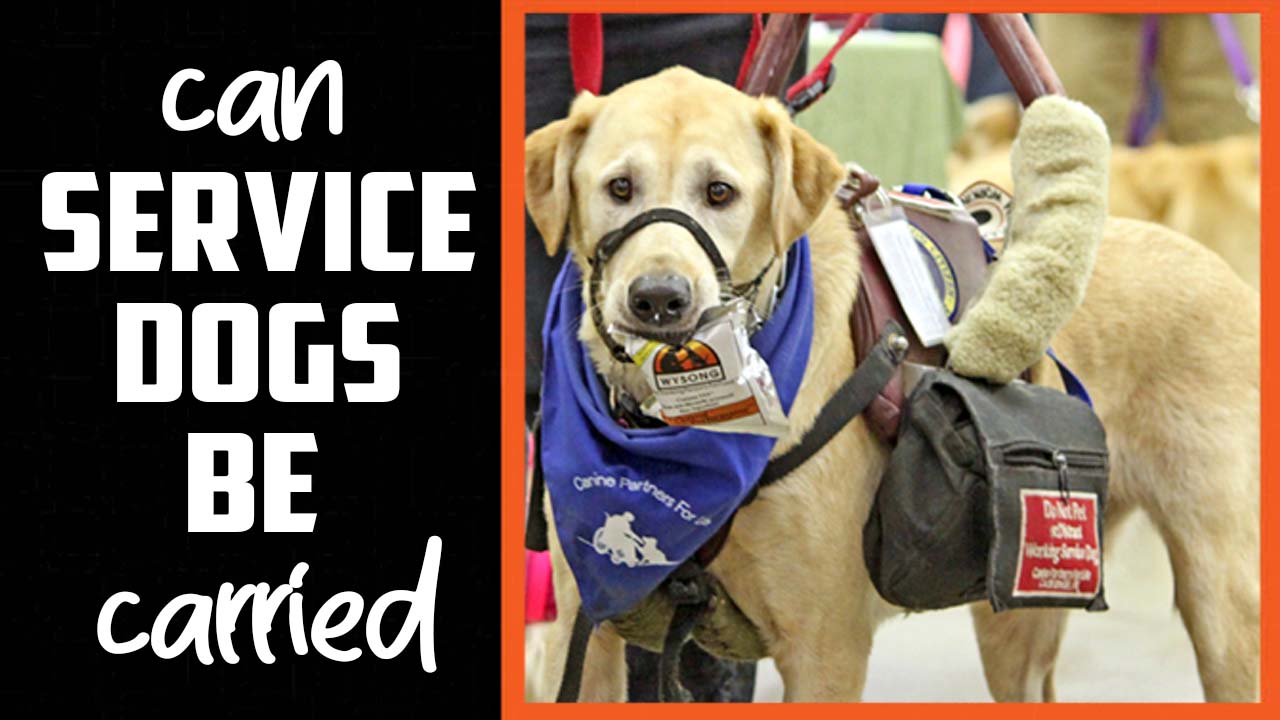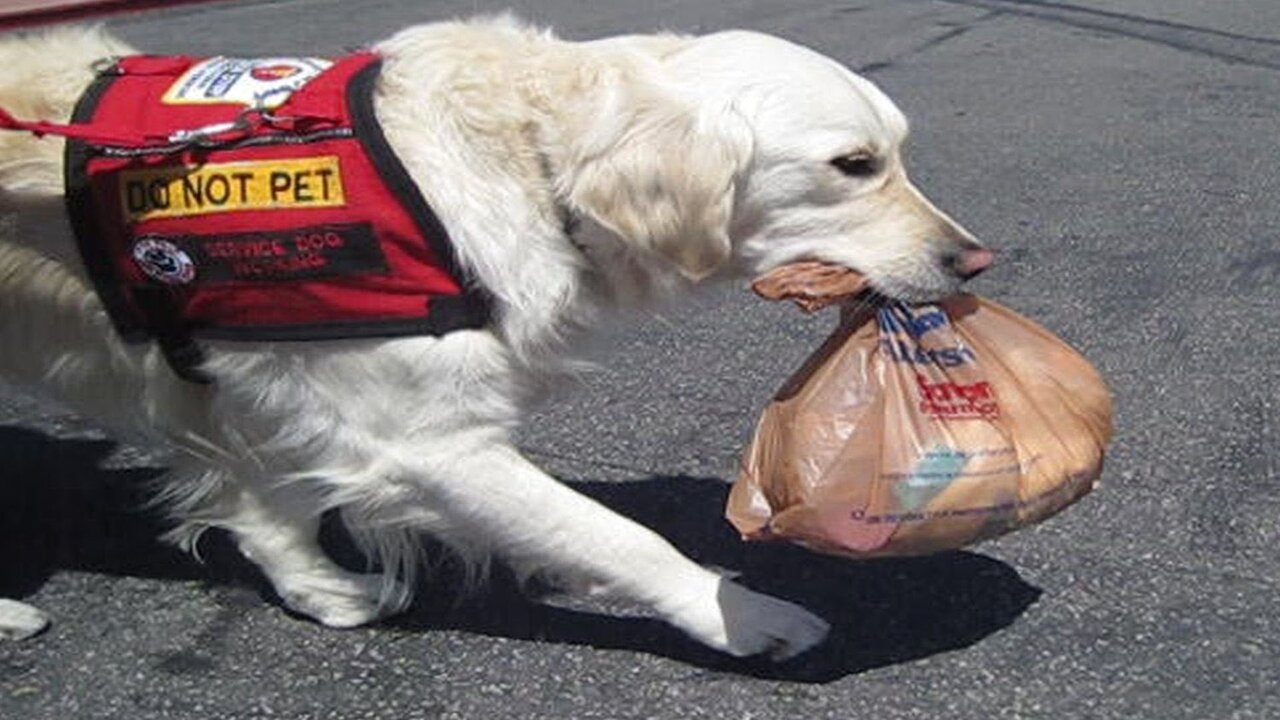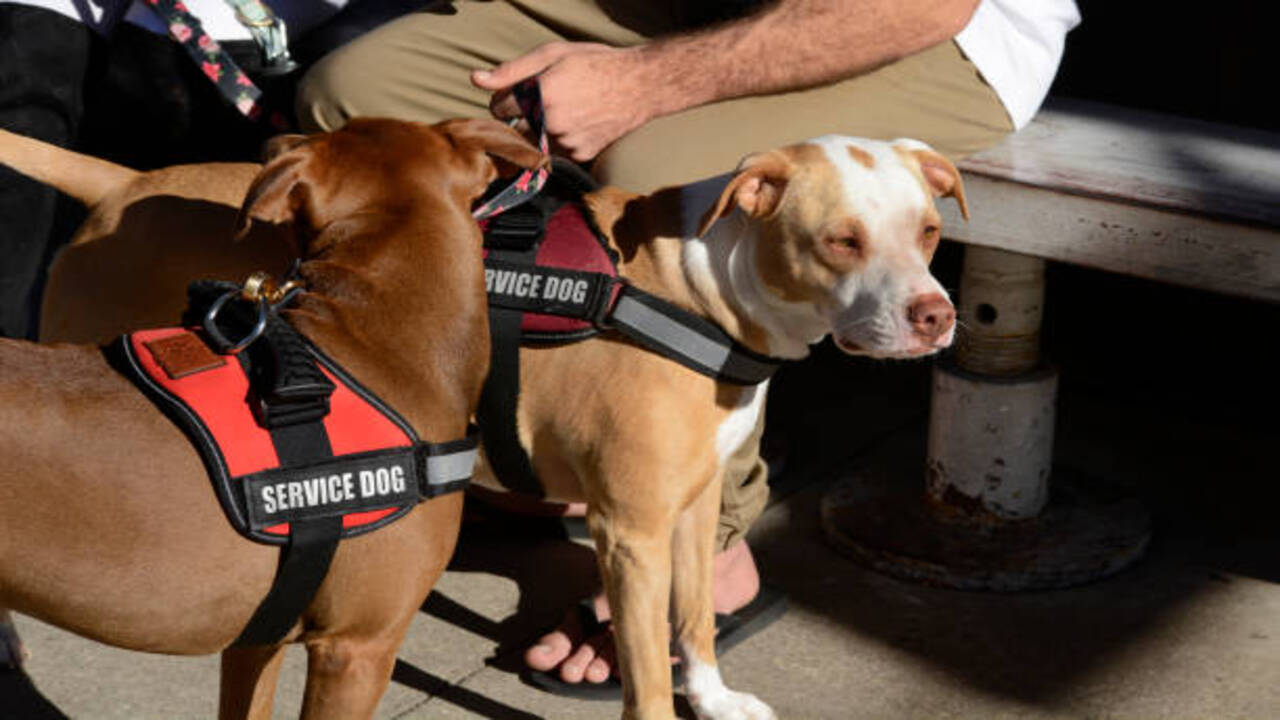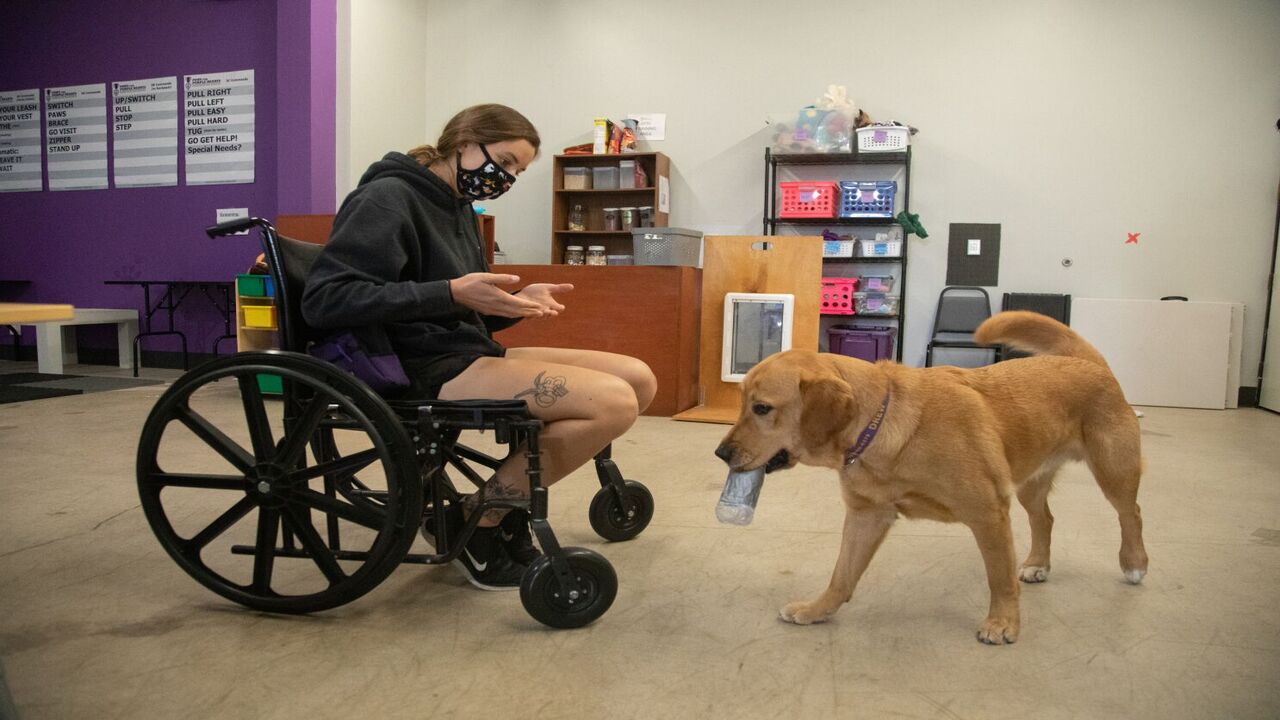Service dogs are crucial in assisting individuals with disabilities and providing them with the support they need to navigate their daily lives. These highly trained and skilled canines perform specific tasks that help their handlers overcome challenges and live more independently.
Handlers typically expect service dogs to walk alongside them. But in certain situations, carrying the dog may be necessary or beneficial. We will explore Can Service Dogs Be Carried and the legal aspects of carrying service dogs, including general rules and regulations.
Certification and registration requirements, and specific breeds commonly used as service dogs. We will also delve into how service dogs can improve the quality of life for individuals. Who needs them, and discuss why some people need to carry their service dogs. Additionally, we will highlight the benefits of carrying a service dog and how they enhance independence and overall well-being.

Can Service Dogs Be Carried? Exploring Legalities

Here are details to know whether Can Service Dogs Be Carried. Regarding carrying service dogs. The legality of the matter can vary depending on the specific laws and regulations in different jurisdictions. Some establishments may permit carrying service dogs in certain situations, such as on public transportation or in places with a “no pets” policy.
However, it’s important to note that one must follow some guidelines and requirements to consider a dog a legitimate service animal. Typically, these guidelines require a person to have their dog trained to perform specific tasks that assist with their disability and to obtain proper documentation or identification for the dog. It’s always best to consult local laws and regulations or seek guidance from organizations specializing in service dog advocacy to ensure compliance with applicable rules.
Legalities Surrounding Service Dogs

The Americans with Disabilities Act (ADA) protects service dogs’ presence in public places. Unlike emotional support animals and therapy dogs, service dogs have specific legal protections that allow them to accompany their handlers in various settings.
While people can allow service dogs in certain situations, they do not have to carry them. For example, establishments with a “no pets” policy often permit service dogs on public transportation.
It is important for businesses and individuals to understand and comply with the laws surrounding service dogs to avoid discrimination or legal issues. This involves ensuring that handlers of service dogs properly train and control their dogs in public to guarantee the safety and comfort of both their handlers and the general public.
General Rules And Regulations
The Americans with Disabilities Act (ADA) protects service dogs and allows them to accompany their handlers in public places. Businesses and establishments must allow service dogs to enter regardless of pet or animal restrictions. Owners must always control and ensure service dogs’ good behaviour.
Even though they are not required to wear a specific vest or identification. It is important to note that businesses cannot ask for proof or documentation of a person’s disability or their dog’s training as a service animal. However, if the owner’s service dog becomes disruptive or aggressive.
Someone may ask them to remove the dog from the premises. These regulations provide accommodations for individuals with disabilities and their service animals, ensuring equal access to public places without unnecessary questioning or burden.
Certification And Registration Requirements
Certain organizations voluntarily offer programs for certifying and registering service dogs, although the law does not mandate it. However, individuals cannot ask to provide proof of certification or registration by businesses and establishments.
Instead, people should focus on providing proper training and documentation to ensure that the service dog becomes well-behaved and capable of performing the necessary tasks. The Americans with Disabilities Act (ADA) safeguards the rights of individuals with disabilities who rely on service dogs.
By protecting the rights of these individuals, the ADA ensures that they have equal access to public places and accommodations. Businesses and establishments must allow service dogs to accompany their handlers. Regardless of any pet restrictions they may have. These regulations ensure that individuals with disabilities can rely on their service dogs for assistance and support without facing unnecessary obstacles or discrimination.
Specific Breeds Of Service Dogs

Trainers can train different breeds of dogs as service dogs depending on the tasks they need to perform. People commonly use Labrador Retrievers, Golden Retrievers, German Shepherds, and Poodles as service dogs. Each breed has its own unique characteristics and abilities that make them suitable for specific tasks.
Size, temperament, and trainability should be considered when selecting a breed for service dog work. However, the most important factor is the individual dog’s temperament, health, and ability to perform the required tasks.
The breed of the service dog plays a crucial role in determining its suitability for different types of disabilities and tasks. By carefully matching the right breed with the specific needs of the handler. Service dogs can effectively assist individuals with a wide range of disabilities.
How Can Service Dogs Improve Quality Of Life?
Service dogs can greatly improve the quality of life for individuals with disabilities. These specially trained dogs can perform various tasks to assist their handlers, such as retrieving items, opening doors, and providing stability and balance.
By helping with these daily tasks, service dogs can enhance independence and mobility for individuals with disabilities. Additionally, service dogs can provide emotional support and companionship, which can help to reduce anxiety and stress. Service dogs are vital in improving the well-being and quality of life of people with disabilities.
Why Do Some People Need To Carry Their Service Dogs?

Some people may need to carry their service dogs for various reasons. One common reason is that the individual may have a medical condition or disability that limits their mobility or ability to walk long distances. In these cases, carrying the service dog can provide them security and assistance, especially in crowded or busy areas where the dog may become overwhelmed or stressed.
Additionally, some individuals may need to carry their service dogs due to physical limitations, such as arthritis or chronic pain, making walking or standing difficult. Carrying the service dog allows them to conserve their energy and reduce any discomfort they may experience. Ultimately, the decision to carry a service dog should be based on the specific needs and capabilities of the individual and their dog.
Benefits Of Carrying A Service Dog
Service dogs offer emotional support and comfort to individuals with disabilities, providing security and companionship. Carrying a service dog enables better mobility and independence for those with disabilities, allowing them to easily navigate crowded or busy environments.
These highly trained dogs can assist with various tasks, such as retrieving medication or aiding in mobility, enhancing the quality of life for their handlers. By carrying a service dog, individuals with disabilities can access the valuable assistance these animals provide, whether alerting them to a medical condition like low blood sugar or helping them navigate through public places.
Service dogs play a crucial role in ensuring the safety of their handlers and the people around them. They also serve as a bridge for social interaction, breaking barriers and promoting inclusivity.
Conclusion
Service dogs are crucial in improving the quality of life for individuals with disabilities. They provide assistance, support, and companionship to those in need. While there are legalities surrounding the carrying of service dogs, it is important to understand the specific regulations and requirements.
Service dogs offer a range of benefits, including increased independence, emotional support, and improved overall well-being. If you or someone you know requires the assistance of a service dog, it is essential to be familiar with the laws and guidelines to ensure a smooth and positive experience.
However, there may be exceptional cases where carrying a service dog is necessary, such as in crowded or unsafe environments. In these situations, it is important for handlers to consult with professionals and follow proper guidelines to ensure the well-being and safety of their service dogs. We hope now you understand can service dogs be carried.
Frequently Asked Questions
Can Service Animals Ride In Strollers?
Service animals, trained to assist individuals with disabilities, may be able to ride in specially designed strollers or carriers depending on the animal’s size and individual needs. Respecting the rights and accommodations of individuals with service animals is important.
Do Service Dogs Get A Carry-On Bag?
Service dogs can usually accompany their handlers in the cabin of an aircraft. Each airline may have specific guidelines on the size and weight of carry-on bags for service dogs. It’s important to check with the airline to understand their policies and requirements.
Can Your Service Dog Sit With You On A Plane?
In most cases, service dogs can accompany their owners on a plane. However, each airline may have specific guidelines and requirements. It is important to check with the airline beforehand and follow their instructions. This may include providing documentation or notifying the airline in advance. Additionally, the airline may require passengers to properly harness or restrain their service dogs during the flight.
How Can You Tell If A Service Dog Is Real?
To determine if a service dog is real, look for specific behaviours and training cues that indicate it’s a service dog. Real service dogs are well-behaved, calm, and focused on their handler. While some wear identifying gear like vests, this isn’t required by law. You can ask the handler about the dog’s status and trained tasks.
Are There Any Limitations Or Restrictions On Carrying A Service Dog?
While there are generally no limitations on carrying a service dog in public places, it is crucial for them to be well-behaved and under control. Some establishments may have specific rules or requirements, such as proper identification. Service dogs are legally permitted to accompany their handlers in areas accessible to the general public.

